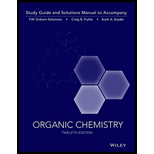
Interpretation:
The structure of the product of the given reaction is to be predicted.
Concept introduction:
Reaction sequences involve conversion of one
These sequences involve a number of steps carried out by different reagents. Sometimes different reagents give the same products.
Electrophiles are electron-deficient species, which has positive or partially positive charge. Lewis acids are electrophiles, which accept electron pair.
Nucleophiles are electron-rich species, which has negative or partially negative charge. Lewis bases are nucleophiles which donate electron pair.
Substitution reaction: A reaction in which one of the hydrogen atoms of a hydrocarbon or a functional group is substituted by any other functional group is called substitution reaction.
Nucleophilic substitution reaction is a reaction in which an electron-rich nucleophile attacks the positive or partial positive charge of an atom or a group of atoms to replace a leaving group.
The involvement of nearby nucleophile substituent to the reaction center in the substitution process is known as neighboring group participation.
Such participation results in an increase of
In this participation, two
Want to see the full answer?
Check out a sample textbook solution
Chapter 6 Solutions
Organic Chemistry, 12e Study Guide/Student Solutions Manual
- Following are the 13C and 1H spectra for one of four isomeric bromoalkanes with formula C4H9Br. Assign a structure of the isomer.arrow_forwardWhen 1-bromobutane is treated with sodium acetate (CH3CO,Na), the major product for the reaction is an ester (CH;CO2CH2CH2CH2CH3). Explain how mass spectrometry and IR spectroscopy could be used to prove that the reaction has occurred and you no longer have the starting material.arrow_forwardThere are several isomeric alcohols and ethers of molecular formula C5H12O. Two of these exhibit the following 1H-NMR spectra. Propose a structure for each of the isomers. Isomer A: δ = 0.92 (t, 7.8 Hz, 3 H), 1.20 (s, 6H), 1.49 (q, 7.8 Hz, 2H), 1.85 (s, 1H) ppm Isomer B: δ = 1.19 (s, 9 H), 3.21 (s, 3H) ppmarrow_forward
- Explain the transitions occurring when acetaldehyde (H-CHO) is exposed to EM radiation. Also explain the two Amax obtained in its UV spectrum by giving out the corresponding spectrumarrow_forwardN-propylbenzene, C6H5CH2CH3, contains C (sp3) -H and C (sp2) -H bonds. Its IR spectrum shows strong or medium absorptions at 3085, 3064, 3028, 2960, 2931 and 2873 cm ^ -1, as well as bands below 1600cm -1. Which statement is wrong? A.) Stretching of the C (sp3) -H bonds results in absorptions at lower wave numbers than the stretching of the C (sp2) -H bonds. B.) The absorptions at 2960, 2931 and 2873 cm ^ -1 are assigned to stretching of the C (sp3) -H bonds. C.) The absorptions at 3085, 3064 and 3028 cm ^ -1they are assigned to stretching of the C (sp2) -H bonds. D.) Each absorption can be assigned to the stretch mode of a particular bond in the propylbenzene molecule.arrow_forwardThe IR and 1H-NMR spectra of a compound with molecular formula C4H7ClO2 are shown below. Your objective as a group is to propose a structure for this compound, explaining how you reach your decision. Using all the information you have been given, in a post with others in your group share your initial ideas about the possible structure of the compound. Then use comments to interact with the other students in the group and propose a final answer to the problem. In the comment phase, you should comment on the postings of at least two other students.arrow_forward
- Treatment of 2-methylpropanenitrile [(CH3)2CHCN] with CH3CH2CH2MgBr, followed by aqueous acid, affords compound V, which has molecular formula C7H14O. V has a strong absorption in its IR spectrum at 1713 cm−1, and gives the following 1H NMR data: 0.91 (triplet, 3 H), 1.09 (doublet, 6 H), 1.6 (multiplet, 2 H), 2.43 (triplet, 2 H), and 2.60 (septet, 1 H) ppm. What is the structure of V? We will learn about this reaction in Chapter 20.arrow_forwardIdentify the C-H out-of-plane bending vibrations in the infrared spectrum of 4- methylcyclohexene. What structural information can be obtained from these bands?arrow_forward1. There are several isomeric alkanes of molecular formula C6H14.Two of these exhibit the following 1H-NMR spectra. Propose a structure for each of the isomers. Isomer A: δ = 0.84 (d, 12 H), 1.39 (septet, 2H) ppm Isomer B: δ = 0.84 (t, 3 H), 0.86 (s, 9H), 1.22 (q, 2H) ppmarrow_forward
- C(CH3)2OH C(CH3):X +H20 where (X=F, CI, Br, I) give reaction with each of halogen as well determine with which halogen substitution reaction is more favorable and feasible and give reason of its feasibility?arrow_forwardThe functional groups in an organic compound can frequently be deduced from its infrared absorption spectrum. A compound containing C, H, and O exhibits broad absorption at 3450 cm-1 (m) and an intense band at 1725, plus a band at 1100 cm-1 (m).Relative absorption intensity: (s)=strong, (m)=medium, (w)=weak. What functional class(es) does the compound belong to? List only classes for which evidence is given here. Attach no significance to evidence not cited explicitly.Do not over-interpret exact absorption band positions. None of your inferences should depend on small differences like 10 to 20 cm-1. The functional class(es) of this compound is(are)fill in the blank 1.(Enter letters from the table below, in any order, with no spaces or commas.) a. alkane (List only if no other functional class applies.) b. alkene h. amine c. terminal alkyne i. aldehyde or ketone d. internal alkyne j. carboxylic acid e. arene k. ester f. alcohol l. nitrile g. etherarrow_forwardGrignard reagents undergo a general and very useful reaction with ketones. Methylmagnesium bromide, for example, reacts with cyclohexanone to yield a product with the formula C7H14O. What is the structure of this product if it has an IR absorption at 3400 cm-1?arrow_forward
 Organic ChemistryChemistryISBN:9781305580350Author:William H. Brown, Brent L. Iverson, Eric Anslyn, Christopher S. FootePublisher:Cengage Learning
Organic ChemistryChemistryISBN:9781305580350Author:William H. Brown, Brent L. Iverson, Eric Anslyn, Christopher S. FootePublisher:Cengage Learning
